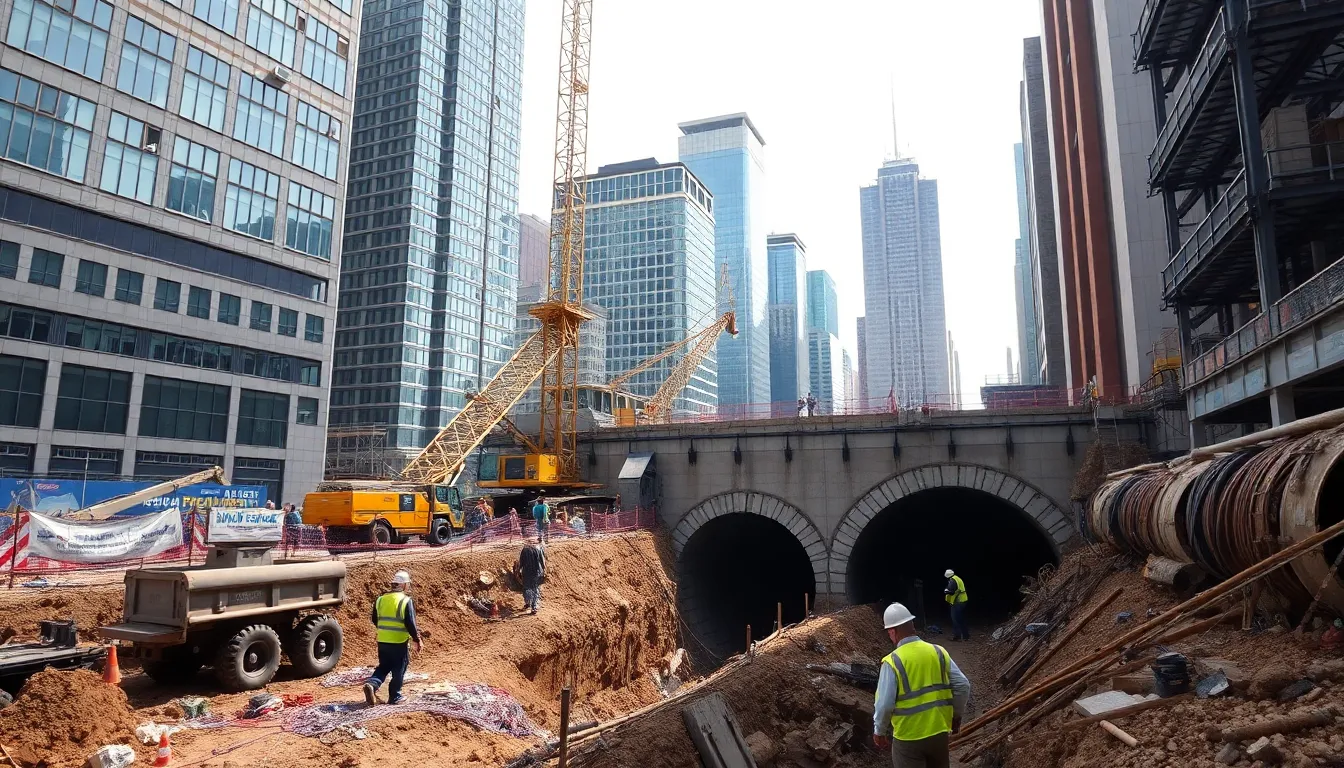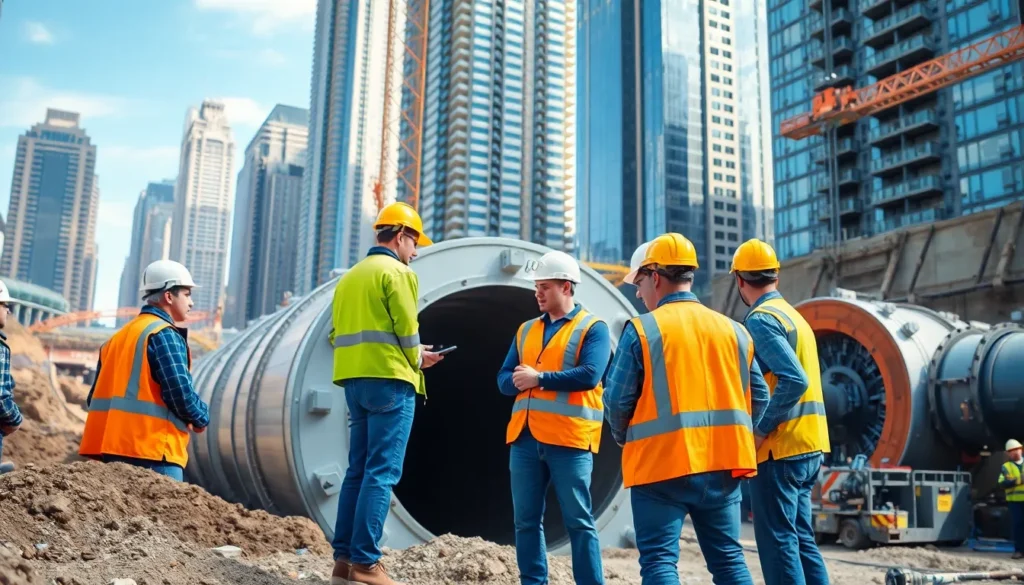Table of Contents
ToggleIn a world where surface space is at a premium, tunneling and underground space technology is digging deep into the future. Imagine a bustling city where traffic jams are a thing of the past, thanks to a network of sleek tunnels whisking commuters beneath the chaos. Sounds like a sci-fi movie, right? Well, it’s happening right now, and the underground revolution is just getting started.
From efficient transportation systems to innovative storage solutions, underground spaces are transforming how we think about urban planning. With advancements in technology, engineers and architects are uncovering new possibilities beneath our feet. So grab your hard hat and get ready to explore how tunneling is not just about digging holes but about shaping a smarter, more sustainable world. Who knew the ground below could be so exciting?
Overview of Tunnelling and Underground Space Technology
Tunnelling and underground space technology encompass various methods and techniques for creating subterranean environments. This technology addresses critical issues in urban areas where land competition intensifies. Engineers employ advanced machinery and innovative materials, enhancing efficiency and safety during construction processes.
Urban planners recognize tunnelling’s potential to expand city infrastructure. By developing multi-layered transportation systems, underground tunnels reduce surface congestion. The capacity to construct facilities below ground affords cities options for efficient land use.
Sustainable development plays a significant role in this field, with projects aimed at minimizing environmental impacts. Techniques such as micro-tunnelling and trenchless technology reduce surface disruption, preserving ecosystems and communities above ground. These methods also lower construction costs and timeframes.
Numerous applications exist within tunnelling and underground technology. Transport networks, water management systems, and emergency response routes utilize these subterranean spaces. Design and execution of these projects require expertise in geology, hydrology, and engineering principles.
The global tunnelling market is on the rise, reflecting increasing demand. It is projected to reach $17.9 billion by 2025, driven by growing urbanization and infrastructure needs. Countries are investing in advanced technologies, further evolving the industry and promoting innovations in tunnel construction and maintenance.
As urban populations rise, the need for smart, efficient solutions will continue to grow. Emerging technologies and improved methodologies contribute to the development of smarter and sustainable urban environments. Cities worldwide actively explore tunnelling and underground space technology to secure a more resilient future.
Importance of Tunnelling in Modern Infrastructure

Tunnelling plays a crucial role in enhancing urban infrastructure, providing a viable solution for cities grappling with limited surface space and growing populations. By utilizing subterranean areas, urban planners can develop efficient transportation and utility networks that meet modern demands.
Applications in Urban Development
Tunneling technology finds various applications in urban development projects. It supports the creation of underground commercial spaces, parking facilities, and utility conduits. Cities utilize tunnels to expand their footprint without encroaching on valuable surface areas. For instance, extensive subway systems help reduce traffic congestion while offering faster commutes. Multi-use tunnels also accommodate diverse functions, such as combined transportation and utilities, which enhances urban planning and resource management.
Transport and Utility Management
Transport systems heavily benefit from tunnelling advancements. Underground transportation solutions like metros and light rail systems improve connectivity and decrease surface traffic. Efficient utility management also relies on underground tunnels for water and sewage systems, ensuring reliable service while maintaining urban aesthetics. Engineers design these networks to be flexible, accommodating future expansions as city populations grow. As a result, tunnelling significantly enhances infrastructure resilience and functionality.
Key Technologies in Tunnelling
Tunnelling technology relies on advanced methods to create efficient underground networks. Two vital technologies in this field include Tunnel Boring Machines (TBMs) and Ground Penetrating Radar (GPR).
Tunnel Boring Machines (TBMs)
TBMs represent the forefront of tunneling machinery. These massive machines excavate tunnels with exceptional precision, minimizing surface disruption. Operators can adjust TBM settings based on geological conditions to enhance efficiency. Different TBM types exist, such as Earth Pressure Balance and Slurry Shield machines, each serving specific ground conditions. By excavating tunnel faces while installing support systems simultaneously, TBMs significantly reduce construction timelines. Those employed in urban areas can even minimize the impact on existing infrastructure. Their ability to bore through various materials makes TBMs essential for complex projects globally.
Ground Penetrating Radar (GPR)
GPR plays a crucial role in subsurface investigation. This technology uses radar pulses to image underground features, providing real-time data to engineers and planners. Operators can assess soil conditions, identify utilities, and locate geological structures accurately. GPR’s non-invasive nature prevents surface disturbance, essential for urban tunneling projects. Engineers utilize GPR surveys before construction to make informed decisions on tunnel routes. Effective utilization of GPR enhances safety, reduces risks, and minimizes unforeseen challenges during excavation. This technology’s ability to generate high-resolution images enables precise tunnel design and planning.
Challenges in Tunnelling Operations
Tunneling operations face multiple challenges that can impact project success. Addressing these issues is essential for developing efficient underground infrastructure.
Environmental Impact Considerations
Environmental impact considerations play a crucial role in tunneling. Projects must assess risks to ecosystems, water systems, and urban communities. Techniques like micro-tunneling mitigate disruptions, preserving existing landscapes. Regulations require thorough environmental assessments before excavation starts. The use of sustainable materials also reduces the ecological footprint of tunneling projects. Importantly, ongoing monitoring during and after construction ensures minimal long-term impact on surrounding areas.
Safety and Risk Management
Safety and risk management remain top priorities in tunneling operations. Workers face hazardous conditions due to confined spaces and heavy machinery. Implementing comprehensive safety protocols minimizes accidents and injuries on-site. Regular training sessions for personnel improve awareness and preparedness. Additionally, real-time monitoring systems help detect unforeseen geological changes and groundwater movements. Proper risk assessments guide decision-making, ensuring that projects adhere to safety standards throughout the excavation process.
Future Trends in Underground Space Utilization
Innovation drives the future of underground space utilization, focusing on efficiency and sustainability. Advanced tunneling techniques aim to reduce urban congestion while maximizing available land. Urban areas increasingly prioritize multi-layered transportation systems, allowing cities to expand infrastructure beneath the surface.
Growth in the tunneling market highlights the increasing demand for subterranean solutions, with projections estimating a market value of $17.9 billion by 2025. Engineers develop smart solutions that integrate with existing city frameworks, enhancing the effectiveness of urban planning. Innovations like micro-tunneling and trenchless technology minimize environmental impacts, preserving ecosystems while expediting construction processes.
Smart cities leverage underground space for diverse applications, including storage facilities and utility conduits. Optimization of land use through underground commercial spaces becomes a key strategy for urban development. Efforts to enhance public transportation, such as underground rail systems, improve connectivity and contribute to reducing surface traffic congestion.
Moreover, robotics and automation in tunneling operations gain attention. These technologies enhance precision and workflow efficiency while minimizing human exposure to hazardous conditions. Real-time data acquisition through Ground Penetrating Radar supports informed decision-making in tunnel routing, increasing safety during construction.
Collaboration among stakeholders fosters a holistic approach to underground space utilization. Architects, engineers, and urban planners work together to design sustainable solutions that meet the needs of growing populations. Overall, the future of tunneling and underground space technology focuses on creating resilient infrastructures that enhance urban living while preserving surface environments.
Tunneling and underground space technology represent a transformative approach to addressing urban challenges. As cities continue to grapple with limited surface space and increasing populations, the need for innovative solutions becomes more pressing. This technology not only enhances infrastructure resilience but also promotes sustainable urban development.
The integration of advanced machinery and techniques ensures efficient and safe construction while minimizing environmental impacts. As the global demand for subterranean solutions grows, collaboration among engineers, architects, and urban planners will be essential. The future of urban living lies beneath the surface, where tunneling technology will pave the way for smarter, more connected cities.




